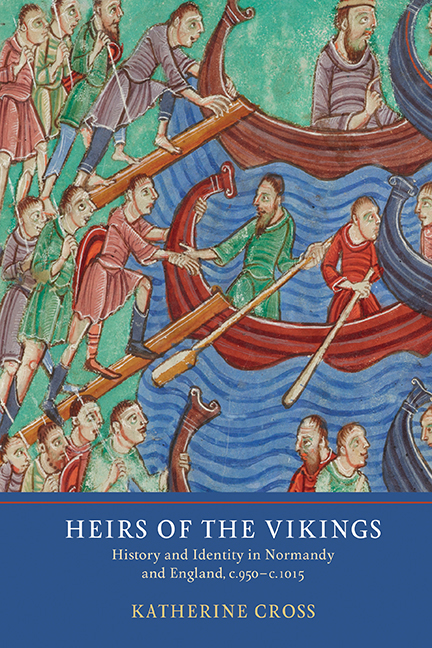Book contents
- Frontmatter
- Dedication
- Contents
- List of illustrations
- Acknowledgements
- Abbreviations
- Note on terminology
- Map
- Introduction: The Problem of Viking Identity
- 1 Genealogy: Building a Viking Age Dynasty
- 2 Origin Myths: A People for a Dynasty
- 3 Hagiography I: Ruin and Restoration
- 4 Hagiography II: Saintly Patronage
- 5 Charter Narratives: Normans, Northumbrians and Northmen
- Conclusion: Viking Age Narratives and Ethnic Identities
- Appendix 1 The Date of Fulbert's Vita Romani
- Appendix 2 The Dates of the Latin Vita Prima Sancti Neoti and the Old English Life of St Neot
- Bibliography
- Index
Appendix 2 - The Dates of the Latin Vita Prima Sancti Neoti and the Old English Life of St Neot
Published online by Cambridge University Press: 19 July 2019
- Frontmatter
- Dedication
- Contents
- List of illustrations
- Acknowledgements
- Abbreviations
- Note on terminology
- Map
- Introduction: The Problem of Viking Identity
- 1 Genealogy: Building a Viking Age Dynasty
- 2 Origin Myths: A People for a Dynasty
- 3 Hagiography I: Ruin and Restoration
- 4 Hagiography II: Saintly Patronage
- 5 Charter Narratives: Normans, Northumbrians and Northmen
- Conclusion: Viking Age Narratives and Ethnic Identities
- Appendix 1 The Date of Fulbert's Vita Romani
- Appendix 2 The Dates of the Latin Vita Prima Sancti Neoti and the Old English Life of St Neot
- Bibliography
- Index
Summary
In Chapter 4, I discuss two texts which relate the life and posthumous miracles of St Neot: the Latin Vita Prima Sancti Neoti and the Old English Life of St Neot. Varied dates have been proposed for these texts’ original composition. Research by Michael Lapidge on the Latin Vita and Malcolm Godden on the Old English Life proposed that they were written in the periods 975x1080 and 1004/1015x1030 respectively. Despite some challenges to their arguments having been raised, I believe that these dates should be upheld, and that the Latin life should be situated in the earlier part of the suggested period. In what follows, I lay out the historical evidence, internal and external, which supports a late tenth or early eleventh century composition for the two saint's lives; and then I consider the relationship between the two texts and a third, post-Norman Conquest version, the Vita Secunda Sancti Neoti. The relationship thus revealed between the two pre-Conquest Lives reinforces an early dating for both.
Historical evidence
Both hagiographies were long considered post-Conquest productions, until the reconsiderations by Lapidge and Godden. The extant manuscripts date from the twelfth to fourteenth centuries, but the evidence given by the texts themselves indicates earlier dates of composition.
The Vita Prima Sancti Neoti is difficult to date with precision, but it seems to have been composed in the late tenth or early eleventh century. It must have been written following the foundation of the priory at Eynesbury (modern St Neots) sometime after 975. Although Neot lived in Cornwall, the Translatio which follows the Vita Neoti (probably by the same author) tells of the translation of his relics to Huntingdonshire. Bishop Æthelwold, the founder of the priory at Eynesbury, is given a role in Neot's life, however anachronistic this might be, again suggesting that the text was written at Eynesbury. Neot is said to rest at Eanulfesbyrig (Eynesbury/St Neots) in the second Resting Places list, compiled in 1013 or slightly later. This casts doubt on William of Malmesbury's suggestion that the relics were moved to Crowland during the years of viking turmoil in the early eleventh century. Viking attacks later became a common reason to claim relics of rival houses, and all the evidence for the presence of Neot's relics at Crowland dates from the early twelfth century. Orderic Vitalis reported c.
- Type
- Chapter
- Information
- Heirs of the VikingsHistory and Identity in Normandy and England, c.950–c.1015, pp. 223 - 228Publisher: Boydell & BrewerPrint publication year: 2018

